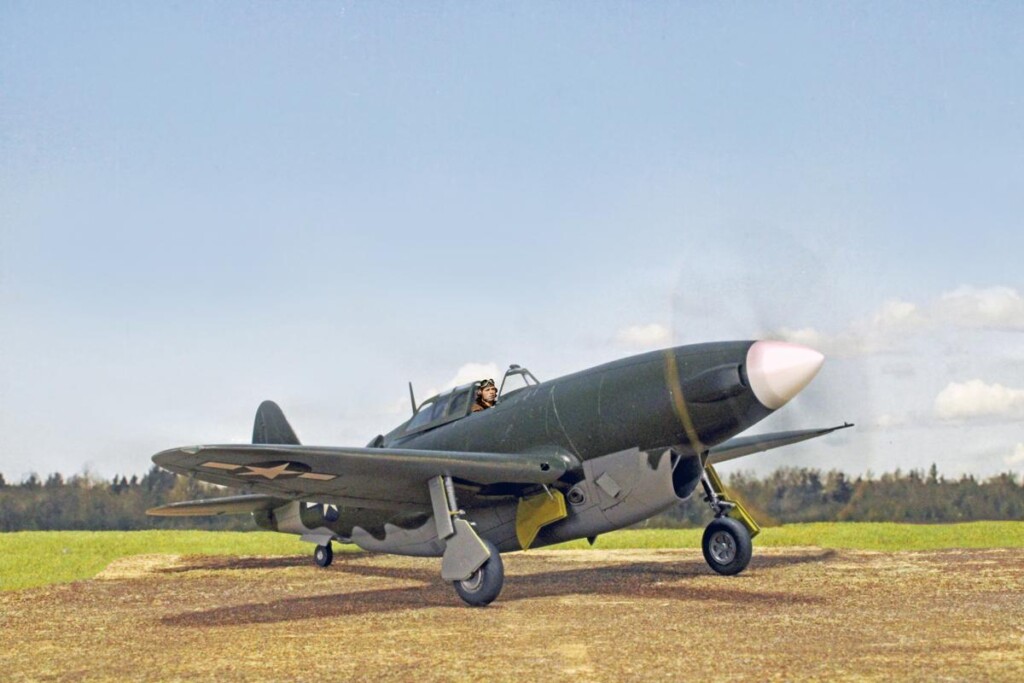It's a HEMI!
Here's my latest build, the Halberd XP-47H conversion. It's an awesome conversion, the Halberd fuselage and Tamiya wings, spars, tailplanes, cockpit and canopy are all a perfect fit.
The recent post by Tom Clever covers the history of this machine I won't duplicate his efforts.
I spent more time researching this airplane and collecting photos than I did building the model.
The massive and radical new XIV-2220 engine of 2500 hp with hemispherical combustion chamber heads developed by Chrysler in 1940 was a pair of inverted V-8 engines joined end to end to form a V-16 over ten feet long. The two V8s were separated by a section housing the prop reduction gear connected to both crankshafts, driving a prop shaft that ran forward.
Conventional wisdom might say that if you are going to design a new fighter aircraft, you might consider the proven engines available and design your new aircraft for it's intended mission to blend with the chosen powerplant. It appears that in this case Chrysler built an engine in search of a suitable aircraft to put it in.
Eventually, two P-47D-15-RAs were pulled from the Evansville production line for modifications to install the Chrysler engine. The program had problems from the beginning. The new engine was supposed to have an axial-flow supercharger, but was not available for whatever reason. The P-47 plumbing in the fuselage was modified and a General Electric CH-5 turbosupercharger was installed. The project progressed slowly as engineers encountered one problem after another, and XP-47H 223297 finally made its first flight a month before the war ended. Its sister ship, 223298, never got off the ground. It was apparent that the Chrysler powered P-47 was doomed, as were many other attempts to install radical new engines to make super piston engined aircraft. Other P-47 projects included installing a Wright R-3350 in the XP-47J and a Pratt & Whitney R-4360 in the XP-72. The aircraft currently in mass production were doing a fine job of winning the war, and it was clear that the future belonged to the jets. The only other aircraft scheduled for installation of the XIV-2220 was the Curtiss XP-60C. That project never got any traction, as the engineers figured that the Curtiss fighter would need several hundred pounds of ballast in the tail. The XP-60C got a R-2800 engine instead.
I painted this model with Tamiya Neutral Grey and OD. Looking at photos, it appears that 223297 had a couple of slightly different paint schemes at different times. One had high scallops demarcating the OD and NG on the nose, and later the demarcation followed the panel lines. Some photos showed air scoops installed on the rear fuselage spine, others did not. Neither airplane had armament, but it looks like 223298 had shell ejector chute cutouts on the bottom of the wing. while 223297 had them faired over or maybe never had them. I believe both airplanes were pulled off the production line unpainted, and got painted after modifications and without all the stencils. I used standard sized national insignia decals from my stash, as the Tamiya kit has oversize insignias. I didn't bother with any weathering, as there were few test flights by 223297 so not much opportunity for fading or chipping. I added Eduard seat belts and 3-D cockpit accessories. Now I'm looking forward to my XP-72!
















Great job, Chas!
I had resisted the urge to order this... but I think now I gotta do it...
Such an interesting aircraft. If they ever could have gotten the figured I’ll bet it would have been wicked.
Chas - great work! Super result!
BTW, while I am definitely clever, I'm a very sharp Cleaver. 🙂
Sorry about that, I'm dyslexic. But nobody ever said that Cleaver isn't clever!
That's looking very, very cool.
Excellent build, Chas.
Very nice work. @chasbunch
It looks awesome Chas! Really nice work. After hearing all the high praise from Mr. Cleaver and yourself about this conversion I think I'll soon be in the market for it. The real aircraft has always held an interest with me, it's awesome that this option is available now.
Awesome job, Chas! Thanks for the background, too!
Wonderful job done on this powerful aircraft, Chas @chasbunch
Great supporting article as well.
Thank for sharing this wonderful build and the accompanying story. Great!
Well done, sounds like the Halbert conversion is a clear winner.
Great work on this build/conversion, Chas, I wish I could have heard this “hemi” when it was fired up.
Nice work, Chas! I never thought I’d see two of these posted in one week.
Great research and build Chas @chasbunch!
Great job on an interesting side story in aviation! Well done, Chas @chasbunch! 👏
A beautifully built and rarely seen aircraft type. I like it very much.
Looks like a fun project!
Great build - such an odd-looking duck!